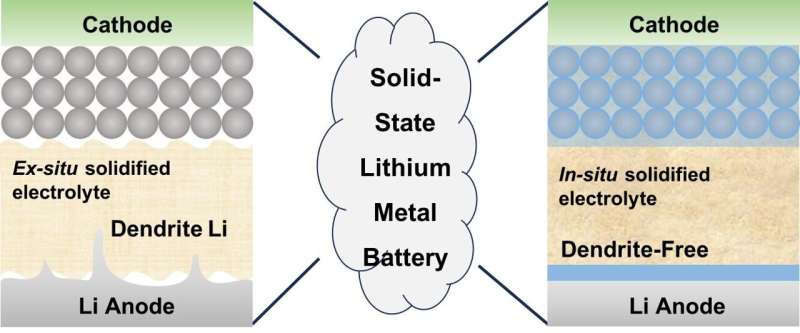This article has been reviewed according to Science X's editorial process and policies. Editors have highlighted the following attributes while ensuring the content's credibility:
fact-checked
trusted source
proofread
A review of solid-state lithium metal batteries through in-situ solidification

At present, the energy density of commercial lithium-ion batteries has been approaching the limit. Liquid lithium metal batteries (LMBs) are favored for their high-energy-density (>500 Wh kg−1), but commercialization is hampered by the flammability and explosiveness of the liquid solvent and the growth of Li dendrites.
A review led by Prof. Qiang Zhang and Prof. Chen-Zi Zhao (Department of Chemical Engineering, Tsinghua University) has indicated forthcoming opportunities to promote the practical applications of in-situ solidification in rechargeable lithium metal batteries. The work is published in the journal Science China Chemistry.
Notably, solid-state LMBs, the core of which revolves around the solid-state electrolyte (SSE) can play a high-energy-density, wide operating temperature, long cycling lifetime and high-safety and other advantages, therefore, the employ of solid-state electrolyte instead of organic liquid electrolyte is a practical strategy to achieve high-performance, high-security LMBs.
"The largest challenge facing the adoption of SSE is the inherent poor solid-solid contacts in solid-state LMBs, which results in huge electrochemical polarization and inferior performance. Especially, when matched with high-areal-loading cathode, how to preserve the conformal interfaces becomes more prominent due to the larger number of pores between the electrode particles," Zhang says.
To tackle the above issue, the emerging in-situ solidification can render the superior conformal contacts between the electrode/electrolyte interfaces, construct the fast ion transport pathway between the electrode/electrolyte and the electrode particle/particle, reduce the interfacial impedance, and improve the electrochemical performance. Markedly, solid-state LMBs based on the emerging in-situ solidification technology have great development potential.
This review addresses the safety of high-energy-density LMBs as an entry point, expounds the importance of in-situ solidification in improving safety and adaptability as well as the history of the development of in-situ solidification, and emphatically introduces the synthesis techniques of in-situ solidified polymer electrolyte.
The practical application of in-situ solidification technology is promoted from the aspects of artificial interphase construction and polymer electrolyte design, respectively, which clarify and establish the importance of in-situ solidification technology in the development of high-performance and high-safety LMBs.
Eventually, the design, challenges and application prospects of in-situ solidified polymer electrolyte are presented to promote the development of existing energy technologies.
More information: Pan Xu et al, A review of solid-state lithium metal batteries through in-situ solidification, Science China Chemistry (2023). DOI: 10.1007/s11426-023-1866-y


















